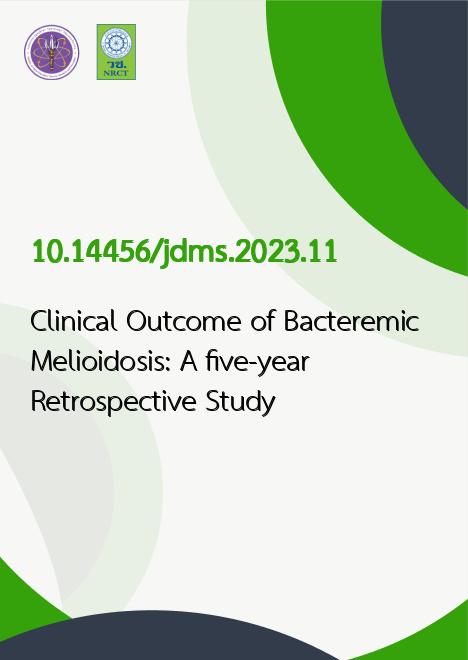
|
Clinical Outcome of Bacteremic Melioidosis: A five-year Retrospective Study |
|---|---|
| รหัสดีโอไอ | |
| Creator | Pradit Wongpangnam |
| Title | Clinical Outcome of Bacteremic Melioidosis: A five-year Retrospective Study |
| Contributor | Sujinda Ruangchan |
| Publisher | สำนักวารสารกรมการแพทย์ |
| Publication Year | 2566 |
| Journal Title | Journal of the Department of Medical Services |
| Journal Vol. | 48 |
| Journal No. | 1 |
| Page no. | 87-92 |
| Keyword | Bacteremic melioidosis, Clinical outcome, Mortality |
| URL Website | https://he02.tci-thaijo.org/index.php/JDMS |
| Website title | วารสารกรมการแพทย์ |
| ISSN | 2697-6404 |
| Abstract | Background: Melioidosis is an infectious disease caused by Burkholderia pseudomallei. It is a disease of public health importance in Thailand and is associated with high fatality rates. Objective: to evaluate clinical outcomes, characteristics, and factors influencing mortality of the patients with bacteremic melioidosis in Songkhla Hospital. Method: A retrospective cohort study of all patients (?15 years old) admitted to the hospital from January 2015 to December 2019 with positive blood cultures for B. pseudomallei was conducted. Result: A total of 81 hemoculture-confirmed B. pseudomallei during the study period. The ages of the patients ranged from 22 to 82 years old, with a mean of 53.27 ? 14.51 years old. At least one underlying disease was documented in 68 (84%) of the patients. Most patients (50 patients, 61.7%) were referred from community hospitals. The common site of infection was a pulmonary infection, which was found in 38% of the patients, disseminated infection in 17.3%, and bacteremia without a documented site of infection was found in 37%. The median (IQR) SOFA score was 4 (0, 9) points. The overall unfavorable outcome was found in 35 patients (43.2%), including in-hospital mortality of 26 patients (32.1%), together with withdrawal treatment for end-of-life care at home for 9 patients (11.1%). Four different factors were found to have significantly influenced the unfavorable outcomes in univariate analysis, including septic shock (68.6% VS 28.3%, p < .001), acute respiratory failure (80% VS 34.8%, p < .001), DIC (20% VS 4.3%, p = .026), and high SOFA score (8 VS 1.5, p < .001). However, none of the comparisons was significant in multivariate analysis. Conclusions: Bacteremic melioidosis has a high mortality rate, and most of the unfavorable outcomes occurred within 72 hours after presentation to the hospital. Patients with septic shock, acute respiratory failure, DIC, and high SOFA scores have significantly higher mortality in univariate analysis. |